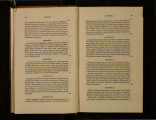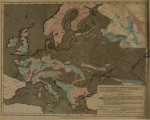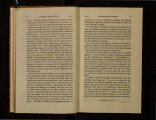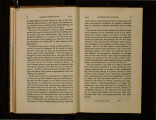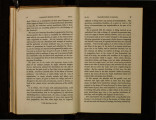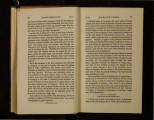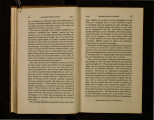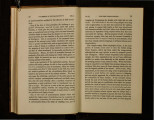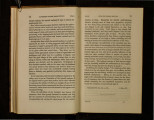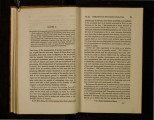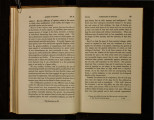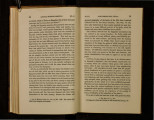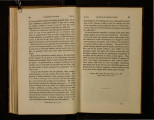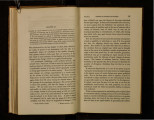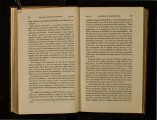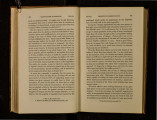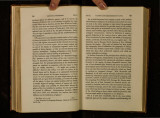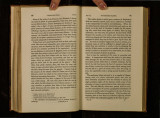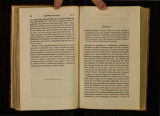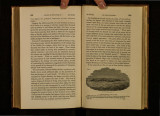| OCR Text |
Show 169l EFFECT OF C HANGES IN :PHYSICAL GEOGRAPHY [Ch. X. . where their principal force is develo~ed, gradua11y the pomts . lar reO'ion where a shght 'k some parucu o 1 d happen to stn e upon . ~r the distribution of an 1 l . dlately auects chanO'e of eve 1mme 1 . t or the barriers between o 1 t f the c Ima e, and water, or t 1e sta e 0 . areas that the rate of f · vcr extensive ' distinct groups o species o d d may in the course of a . b accelerate ' an ' d b fluctuauon ecomes . . o·htier changes than ha een few years or centunes, work IDlb . . d of antecedent years. experienced m myna s . . f subsidences causing the ~ 1 a repetitiOn o Thus, 10r examp e, • . k down a few hundred feet, narrow isthmus of Panama t~ sm b t a great revolution in . brmg a ou might in a few centuries . . the western hemisphere. f 1 • ate creatiOn m . the state o t 1e amm . . ld pass for the first time d 'i! tic spectes wou f Thousan s OL aqua . h p cific. and thousands o 'bb Sea mto t e a ' . from the Can ean P 'fi cean would make their ~ r r to the aci c 0 ' others, belore pecu Ia h Gulf of Mexico, and the 'bb · Sea t e way into the Can ean a' 'fi t' on would probably be OC· · A 'derab1e mo I ca I h Atlantlc. consi . h direction or volume of t e casioned by the same event m t e ture of the sea and the d thereby the tempera f Gulf-stream, an 1 d far as the influence o . 1 d would be a tere as b contlguous an s h f climate might thus e t ds A c ange o d . that curre~t ex en . m Florida to Spitzbergen, an m produced m the ocean fro . Europe and Greenland. many countries of North Amenc~, f . 'n 'which falls would 1 1 t b t the quantity o rai Not merely t 1e 1ea ' u ies would be . d' . t so that many spec be altered in certam Istrtc s, b f, flourished; others excluded from tracts where theyd e ore uld thrive more d . ber . an some wo would be reduce m num l ' d th fruits of plants would no and multiply. The seed~ a so an e directions, nor the eggs longer be drifted in precisely the sdame . be any longer im· of · 1 ither woul species aquatic amma s ; ne . 1 r stations before . t. towards parbcu a peded. in their migra Ions . . . . s the mighty shut out from them by their mabihty to eros current. art of the globe which Let us take another example from a p k iz the ]oW bl ffi by earthqua es, v ., is at present lia e to su er f Azof and the sandy tract which intervenes between the sea o Ch. X.] O'N THF. DlSTRlilUTTON OF SPECIES. 168 Caspian. If there should occur a sinking down to a trifling amount, and such ravines should be formed as might be produced by a few earthquakes, not more considerable than have fallen within our limited observation during the last one hundred and forty years, the waters of the sea of Azof would pour rapidly into the Caspian, which, according to the lowest estimate, is fifty feet lower than the level of the Black Sea, and which, according to some writers of considerable authority, is one hundred and fifty feet,-according to others, three hundred feet below the level of the Sea of Azof *· '"!'he latter sea would immediately borrow from the Euxine, the Euxine from the Mediterranean, and the Mediterranean from the Atlantic, so that an inexhaustible current would pour down into the low tracts of Asia bordering the Caspian, by which all the sandy salt steppes adjacent to that sea would be inundated. The diluvial waters would reach the salt lake of Aral, nor stop until their eastern shores were bounded by the high land which in the steppe of the Kirghis connects the Altay with the Himalaya mountains. A few years, perhaps a few months might suffice for the accomplishment of this great revolution in the geography of the interior of Asia; and it is impossible for those who believe in the permanence of the energy with which existing causes now act, not to anticipate such events again and again in the course of future ages. Let us next imagine a few cases of the elevation of land of small extent at certain critical points, as, for example, in the shallowest parts of the Straits of Gibraltar, where the soundings from the African to the European side give only two hundred and twenty fathoms. In proportion as this submarine barrier of rock was upheaved, to effect which would merely require the shocks of partial and confined earthquakes, the volume of water which pours in from the Atlantic into the Mediterranean would be lessened. But the loss of the inland sea by evaporation would remain the same, so that being no ,.. Malte-Brun, vol. vi. p. 405, |










